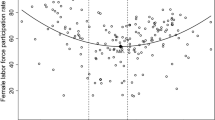Abstract
This paper analyzes the role of public policy for Sweden's combination of high female labour force participation and high levels of fertility in the late 1980s and early 1990s. We present the central elements in the tax and family policies and use a disaggregated approach to assess their impact on Swedish fertility and female labour force participation. We show that these policies stimulate both fertility and women's paid work by reducing the costs of having children while requiring parents to be employed to collect full benefits.
Résumé
Cet article analyse le rôle des politiques sur le lien entre une forte participation féminine au marché du travail et de hauts niveaux de fécondité en Suède, à la fin des années 1980 et au début des années 1990. Nous présentons d'abord les principaux éléments des politiques fiscales et parentales. Puis nous utilisons une approche désaggrégée pour mettre en évidence leur impact sur la fécondité suédoise et la participation féminine au marché du travail. Nous montrons que ces politiques stimulent à la fois la fécondité et le travail féminin rémunéré en réduisant les coûts en vue d'élever les enfants tout en demandant aux parents d'être actifs pour en recueillir les pleins bénéfices.
Similar content being viewed by others
References
Björklund, A., Hamilton, C.B., Jacobsson, U., Jönsson, B. and Söderström, H.T., 1989. Den svenska modellen inför 90-talet. SNS Förlag, Stockholm.
Blomquist, N.S. and Hansson-Brusewitz, U., 1990. The effect of taxes on male and female labor supply in Sweden. Journal of Human Resources, 25: 317–357.
Bumpass, L.L., 1990. What's happening to the family? Interactions between demographic and institutional change. Demography, 27 (4): 483–498.
Burtless, G. 1987. Taxes, transfers, and Swedish labor supply. In: B.P. Bosworth and A.M. Rivlin, eds. The Swedish Economy. Brookings Institution, Washington, DC: 185–242.
David, M.-G. and Starzec, C., 1991. France: a diversity of policy options. In: S.B. Kamerman and A.J. Kahn, eds. Child Care, Parental Leave, and the Under 3s Policy Innovation in Europe. Auburn House, Westport, CT: 81–113.
Eurostat, 1991. Demographic Statistics 1991. Eurostat, Luxembourg.
Flood, L., 1990. Att mäta och estimera utbudet av arbetskraft, 1990. In: A. Klevmarken, ed. Tid och råd. Industrial Institute for Economic and Social Research, Almqvist & Wiksell, Stockholm: 75–97.
Gustafsson, S., 1990. The labor force participation and earnings of lone parents. In: Lone Parent Families: the Economic Challenge. OECD, Paris: 151–172.
gustafsson, S., 1992. Separate taxation and married women's labor supply: a comparison of West Germany and Sweden. Journal of Population Economics, 5: 61–85.
Gustafsson, S. and Stafford, F.P., 1992. Childcare subsidies and labor supply in Sweden. Journal of Human Resources, 27 (1): 204–230.
Haas, L., 1990. Equal parenthood and social policy: a study of parental leave in Sweden. Unpublished manuscript, Department of Sociology, Indiana University IN.
Hoem, B. and Hoem, J.M., 1988. The Swedish family: aspects of contemporary developments. Journal of Family Issues, 9: 397–424.
Hoem, J.M., 1990. Social policy and recent fertility change in Sweden. Population and Development Review, 16: 735–748.
Hoem, B. and Hoem, J.M., 1988. The Swedish family: aspects of contemporary developments. Journal of Family Issues, 9: 397–424.
Juster, F.T. and Stafford, F.P., 1991. The allocation of time: empirical findings, behavioral models, and problems of measurement. Journal of Economic Literature, 29: 471–522.
Knudsen, R., 1990. Familieydelser i Norden 1989. Teknikse rapporter No. 52, Nordisk Statistisk Sekretariat, Copenhagen.
Ministry of Finance, 1991. Regeringens budgetförslag 1991/92. Allmänna Förlaget, Stockholm.
Näsman, E., 1992. Föräldraledighetslagen i tillämpning. Work in progress, Demographic Unit, Stockholm University, Stockholm.
National Insurance Board, 1985. Föräldraledighet i samband med barns födelse. Barn födda 1978–1982. Statistisk rapport 1985: 4, National Insurance Board, Stockholm.
National Insurance Board, 1989. Föräldrapenning med anledning av barns födelse avseende 1988. Statistik information Is-I 1989: 24, National Insurance Board, Stockholm.
National Insurance Board, 1990. Uttag av föräldrapenning med anledning av barns födelse under barnets första levnadsår. Statistik information Is-I 1990: 16, National Insurance Board, Stockholm.
OECD, 1990. Employment Outlook. OECD, Paris.
Statistics Sweden, 1988. Barnomsorgsundersökningen 1987. Statistics Sweden, Stockholm, 1988.
Statistics Sweden, 1989a. Barnomsorgsundersökningen 1988. Statistics Sweden, Stockholm.
Statistics Sweden, 1989b. Revision of Contents and Definitions in the Swedish Labour Force Surveys 1989: 3. Statistics Sweden, Stockholm.
Statistics Sweden, 1990. The Swedish Labour Force Surveys 1990: 3. Statistics Sweden, Stockholm.
Stein, G., 1989. Det sociala skyddsnätet i Sverige och EG, Aktuell information. Näringslivets Ekonomifakta, Stockholm.
Sundström, M., 1987. A Study in the Growth of Part-time Work in Sweden. Swedish Center for Working Life, Almqvist & Wiksell, Stockholm.
Sundström, M., 1991a. Part-time work in Sweden: trends and equality effects. Journal of Economic Issues, 25: 167–178.
Sundström, M., 1991b. Sweden: supporting work, family, and gender equality. In: S.B. Kamerman and A.J. Kahn, eds. Child Care, Parental Leave, and the Under 3s Policy Innovation in Europe. Auburn House, Westport, CT: 171–199.
Sundström, M., 1991c. The growth in full-time work among Swedish women in the 1980s. Paper presented at the 3rd EALE-Conference, El Escorial, Madrid.
Tegle, S., 1985. Part-time employment. Lund Economic Studies No. 35, Department of Economics, University of Lund.
Author information
Authors and Affiliations
Rights and permissions
About this article
Cite this article
Sundström, M., Stafford, F.P. Female labour force participation, fertility and public policy in Sweden. Eur J Population 8, 199–215 (1992). https://doi.org/10.1007/BF01797210
Received:
Revised:
Issue Date:
DOI: https://doi.org/10.1007/BF01797210




